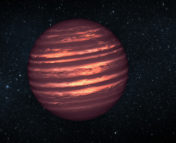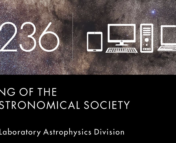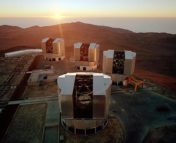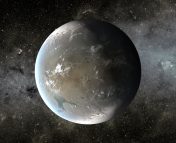In this series of posts, we sit down with a few of the keynote speakers of the 237th AAS meeting to learn more about them and their research. You can see a full schedule of their talks here, and read our other interviews here!
Want to know what it’s like on an exoplanet? Dr. Caroline Morley can answer that for you. Her specialty is exoplanet atmosphere science, combining both theory and observations to understand the chemistry, clouds, atmospheric escape, and more on these far away worlds. (Bonus: she also used to write for Astrobites in its early days!)
Morley is now an Assistant Professor at University of Texas, Austin, and has earned the Annie Jump Cannon Award at AAS 237. This award recognizes “outstanding research and promise for future research by a postdoctoral woman researcher” and is being awarded to Morley “For her innovative work on modeling the atmospheres of exoplanets and brown dwarfs. She has advanced our understanding of clouds and photochemical hazes and the role they play in observations of transmission and emission spectra.”
On her path into astronomy, Morley recounts how she “was the 5-year-old who wanted to be an astronaut (and a ballerina, but I dropped out of ballet before I turned 6), so something about space has always fascinated me…Astronomy is the thing I kept coming back to.” As an undergraduate at MIT, she recalls having “some truly inspiring professors, including Max Tegmark and Sara Seager.” However, the path was not without challenges. She describes how she almost didn’t apply to graduate school; between the demoralizing Physics GRE and a particularly heavy semester of quantum mechanics and “Junior Lab” (a supposedly infamous course at MIT), she was worried about her chances of getting in. Thankfully a she “had a good, really straight-talking friend who told me that I was being silly” and ended up going to UC Santa Cruz for her PhD. She recalls that she “chose UCSC not solely because the campus is like a glorious summer camp in the redwood trees, but certainly that helped. Gotta be happy in graduate school — happy grad students are the most productive.” After some time as a Sagan Fellow postdoc at Harvard, she became faculty at UT Austin, where she is now.
One of the most formative parts of her research journey was the first data release from the Kepler mission.
“It was during my first year of graduate school; there had only been a couple of transiting super Earths discovered before that, and suddenly there were hundreds of planet candidates between Earth and Neptune in size. No one expected to see all these mid-size planets on compact orbits. No one predicted that these planets would be perhaps the most common in the galaxy. To me, it fundamentally changed how I thought about planets, and about our solar system’s place in the galaxy. The mystery of what these planets are — “super Earths”? “sub Neptunes”? Mini Neptunes? Neptinis? — is one that we’re still grappling with today.”
Her group is, in fact, still grappling with these mysteries, working on multiple facets of exoplanet atmospheres. One big focus at the moment is proposing for time on the James Webb Space Telescope (JWST)—Morley says “Exoplanet atmosphere science is going to be transformed by the data we get with JWST, and everyone is excited.” Her student, Jessica Luna, is currently working on how rock clouds (yes, rock clouds!) made of silicate condensates affect warm exoplanet atmospheres and how we can distinguish them in JWST spectra. Another project in her group is to observe escaping exoplanet atmospheres with the Hobby-Eberly Telescope. They’ve also been using Gemini Observatory to observe one of her favorite objects, the “vastly-underappreciated free-floating planet WISE 0855” which is “cold — colder than the Earth! colder than the telescope we observed it with!” (shown in Figure 1). They’ve found water vapor, methane, hints of water ice clouds, and variability (detected by Spitzer!) “which tells us there’s weather, perhaps like Jupiter’s Great Red Spot.” And recently Morley has returned to her “roots as a scientist, generating new models for brown dwarf atmospheres with all the latest-and-greatest ingredients: new chemistry, new line lists, new cloud properties.”
Morley has some great pieces of advice to share with students, too. Her first piece of advice for graduate students is to “travel early and often. Get creative with funding if you have to (a lot of conferences and workshops offer some support for students), but it’s inspiring, gives you a big picture of how your work fits in, and starts to build your network.” And she even has a secret about networking…although students often stress about meeting “bigwigs” at conferences, “the bigwigs aren’t that important. Your ‘conference buddies’ are what’s important. The friends you make at conferences will later become your support network. Your close collaborators. Your “friend in industry” who hooks you (or a friend) up with a data science gig. Yes, feel free to get all stressed about your meeting with Esteemed Scientist XYZ. But cultivate a close-knit, inclusive, welcoming group of conference buddies who will have your back though good times and bad.”
She continues, saying “I feel a little bad now that I’ve given two pieces of advice that are not especially actionable during a global pandemic. Here’s one that you can use now, at any career level: Always ask for the things you need, couch the request in your productivity and success, and NEVER apologize when you ask. If you need a computer to do research on, tell your advisor that to be successful, you need to borrow a machine. If you need meetings twice a week to stay accountable with research, tell your advisor, without suggesting this would waste their time. If you need a lactation room in the building after having a baby, tell your department chair, without implying that doing so would make you a burden. As it turns out, everyone in a leadership role actually appreciates when they have concrete ways to make their team productive and successful.”
To hear more from Dr. Caroline Morley about her cool exoplanet science, be sure to tune into her AAS 237 plenary talk “Hazy Views of Nearby Worlds: Standing Between Two Eras of Exoplanet Characterization” on Wednesday, January 13th 5:50-6:40pm ET!
Astrobite edited by: Ellis Avalone
Featured image credit: American Astronomical Society




